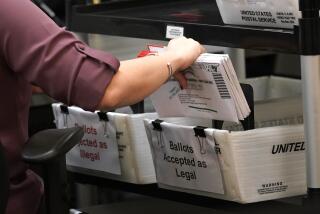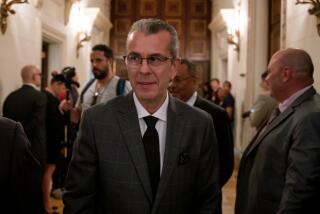All-Digital Voting Keeps Polls Pulsing in Brazil
SANTA ROSA DO PURUS, Brazil — The closest thing to a computer in Manoel Perreira Kaxinawa’s tiny village is a calculator, one of two shared by the hamlet’s 160 inhabitants. So after a three-day journey upriver to this remote Amazon town, through thick, impenetrable jungle, Perreira was more than ready to glimpse an electronic voting machine.
An election official walked him through a demonstration. Perreira, about to vote for the first time in his life, punched in the numbers of his preferred candidates like a natural, a quick and painless practice run for election day today.
For the record:
12:00 a.m. Oct. 6, 2004 For The Record
Los Angeles Times Wednesday October 06, 2004 Home Edition Main News Part A Page 2 National Desk 1 inches; 50 words Type of Material: Correction
Brazil vote -- A photo caption in Sunday’s Section A with an article about voting in Brazil said that electoral worker Erimar Silva da Costa was checking the voter register in Santa Rosa do Purus. The photo showed Manoel Perreira Kaxinawa conducting a practice run on an electronic voting machine.
“I think it’s very cool,” said Perreira, 25, a member of the Kaxinawa tribe that lives deep in the rainforest. “It was easy.”
Throughout this vast country, officials have deployed more than 400,000 such machines that voters will use to choose mayors for Brazil’s 5,500 cities.
With a population of 180 million living in an area larger than the continental U.S., Brazil is the world’s biggest country to have fully automated voting. From small jungle towns to huge industrial centers like Sao Paulo, citizens have done without paper ballots since 2000.
The government hails the system as a triumph that puts Brazil on the cutting edge. Voting -- mandatory by law -- has become easier for millions, including the nation’s many illiterates, who can see a photo of their chosen candidate on the computer screen. Results are known a few hours after polls close.
But the successes of the system have masked what critics say are serious flaws that the government has failed to address adequately.
With no paper trail and imperfect supervision, critics contend, the voting machines are susceptible to tampering by hackers and crooked officials -- both of whom are in ample supply. The extremely technical nature of the system can make fraud more difficult to detect.
“Some may pretend, and others believe, that Brazil’s long-standing culture of electoral manipulation and collusion went away simply because of [electronic voting] machines,” said Pedro Antonio Dourado de Rezende, a computer science professor in Brasilia, the capital. “But these positions require more gullibility than I can stand.”
Similar concerns about the reliability of computerized voting are being raised in the U.S., where the Florida debacle in the 2000 presidential contest gave impetus for hauling the nation’s electoral process into the digital age.
Next month, 29% of registered U.S. voters are expected to use touch-screen voting machines, more than double the percentage four years ago. Some officials are warning of problems with devices built by companies such as Diebold Election Systems, which is a major supplier of voting machines in the U.S. and Brazil.
Brazilian officials said that no significant cases of election fraud had emerged since electronic voting went national four years ago.
They cite safeguards against tampering, such as the presence of representatives from different political parties when the machines are installed and the names and photos of candidates are loaded.
Portions of the computers’ “source code,” or programming instructions, also have been opened to inspection.
“Our voting system has been in use since 1996,” said Paulo Cesar Bering Camarao, the head of the computing department of Brazil’s federal elections tribunal. “Do you think by any chance that ... our specialists haven’t come up with the best solution?”
The government is so confident of its pioneering methods that it speaks of exporting its system to other Latin American countries. After the 2000 U.S. presidential election, editorials here bragged about having the solution to America’s vote-tallying woes.
But critics say that the lack of major fraud cases may simply be the result of a regulatory process that concentrates all power on electoral matters in the hands of the federal elections tribunal. The body, an offshoot of the judiciary, was one of the chief backers of automated voting; it implemented the program and is responsible for policing the system it set up. That, detractors say, gives the tribunal a vested interest in claiming success and hushing up problems.
And a few problems have arisen -- some of them minor glitches, others more serious allegations of vote-rigging.
During the first round of Brazil’s presidential election two years ago, the mainframe tabulating the votes briefly went haywire, changing Luiz Inacio Lula da Silva’s tally from more than 1 million to an impossible minus 41,000.
After “some screams” and a scramble to find the bug, the correct count flashed on the screen, Rezende wrote in a paper presented this year at Rutgers University. An official blamed a “formatting error” for the blip, which went largely unreported by the Brazilian media.
Last month, an alleged vote-fixing scheme surfaced in Rio de Janeiro. Police there are investigating whether an electoral official helped two local politicians in 2000 and 2002 by swapping computer disks or manipulating software to favor them in the vote count.
The ensuing scandal has pointed up what critics say is the lack of a credible way to challenge the final tally in an election. In Brazil, the computer has the first and last word on who wins. But what if it makes a mistake or somebody rigs its software?
Elections officials insist that such fraud is impossible because the various political parties watch the programming of the machines and then seal them. Tampering would require a massive conspiracy involving election workers, candidates and technicians, an effort one official likened to getting 10 people to turn 10 different keys at the same time to break into a safe.
“We’ve conducted votes since 1996 with electronic machines and, up to now, in the whole country, nobody has figured out how” to pull off such a scheme, Rio Judge Arturo Narciso de Oliveira Neto told the Jornal do Brasil.
Concerned academics, specialists and technicians have lobbied for printers to be hooked up to voting machines, to create a paper record that would back up the electronic tally and allow for a manual recount. But the government has dismissed the idea as unwieldy and unnecessary.
“They say it is too expensive,” said Mario Jacobskind, a journalist and editor of the book “Electronic Fraud,” a highly critical examination of Brazil’s automated voting system. “They also say it slows down the process.”
A legislative effort in 2001 to demand a paper backup ended up with so many amendments inserted by the federal elections tribunal that critics said the bill, though approved by Congress, was essentially toothless.
The measure stemmed from a voting-machine scandal. Lawmakers pushed for better security after the president of the Senate revealed that a loophole in the chamber’s computerized system had allowed him to spy on his colleagues -- to see how each of them voted in a supposedly secret ballot to expel a corrupt fellow senator.
Still, many Brazilians place great faith in their high-tech system and are trying to make other leaps forward.
For the first time here in Santa Rosa, on the banks of the Purus River -- on the other side is Peru -- a satellite hookup will enable officials to upload votes from separate polling stations to a regional tabulation center immediately after polls close. In the past, the voting machines’ disks had to be hand-delivered, which delayed announcement of results by at least a day.
“Here’s a comparison. In olden days, it used to take two months to get to Europe by boat. Now you can get there in 12 hours,” said Rosana Magalhaes da Silva, a regional electoral official. “The same kind of thing is happening to us.”
Elections in sleepy, sweltering Santa Rosa, the smallest municipality in Acre state, are a festive occasion. Indigenous residents arrive days early by boat, the only way to reach this town except by light aircraft. The visiting voters sleep in hammocks in a preschool on Santa Rosa’s only street, which is lined on either side with boxy, Monopoly-like wooden houses with corrugated metal roofs.
“They like to vote,” said vice mayoral candidate Jose Domingos, also a Kaxinawa Indian. “They want to see their candidates win and for them to help them out afterward.”
More to Read
Sign up for Essential California
The most important California stories and recommendations in your inbox every morning.
You may occasionally receive promotional content from the Los Angeles Times.











